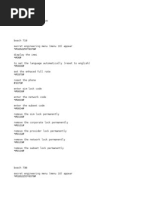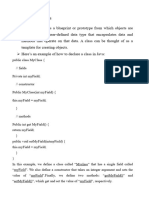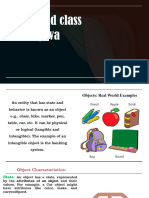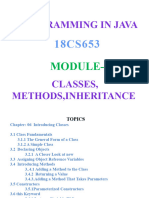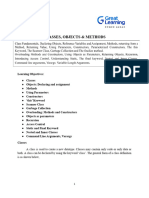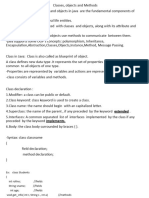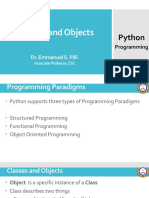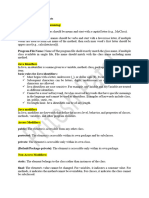Classes and Objects
Uploaded by
Varsha PatilClasses and Objects
Uploaded by
Varsha PatilClasses & Objects
Definition of Class:
Class defines a new data type. Once defined, this new type can be used to create objects of that type. Thus, a class is a template for an object, and an object is an instance of a class. In other words, class is a collection of fields (instance and class variables) and methods.
General Form of Class:
A class is declared by the use of the class keyword. Simplified general form of a class definition is shown below: class classname { type instance-variable1; type instance-variable2; // ... type instance-variableN; type methodname1(parameter-list) { // body of method } type methodname2(parameter-list) { // body of method } // ... type methodnameN(parameter-list) { // body of method } } The general form of a class does not specify a main( ) method. Java classes do not need to have a main( ) method. We only specify one if that class is the starting point for our program. Further, applets dont require a main( ) method at all.
The data, or variables, defined within a class are called instance variables. The code is contained within methods. Collectively, the methods and variables defined within a class are called members of the class. Detail about An instance variable is a variable that is defined in a class, but outside of a method. There is one copy of the variable for every instance (object) created from that class.
A common problem is trying to reference an instance variable from a static method. A static method (eg, main) can only reference static variables in its own class (or its own local variables). Creating object of the class A class is merely a plan for a possible object. It does not by itself create any objects. When a programmer wants to create an object the new operator is used with the name of the class. Creating an object is called instantiation. Object Declaration : An object is declared using a variable name(object name) and type of the objects. Mainclass mc; Object Instantiation : The 'new ' key word is used to create the object. mc = new Mainclass(); Object Initialization (Optional step): The 'new' keyword is followed by a call to a constructor. This call initializes the new object. mc = new Mainclass("Ankit");
You might also like
- The C# Player's Guide - 5th Edition - 5.0.083% (18)The C# Player's Guide - 5th Edition - 5.0.0497 pages
- Ap Computer Science Principles Practice Exam and Notes 2021100% (4)Ap Computer Science Principles Practice Exam and Notes 2021108 pages
- Hacking The Art of Exploitation 2nd Edition Jon Erickson100% (19)Hacking The Art of Exploitation 2nd Edition Jon Erickson492 pages
- Introducing: Lab # 5 Classes, Methods and ConstructorNo ratings yetIntroducing: Lab # 5 Classes, Methods and Constructor7 pages
- The Concept of Java Classes and ObjectsNo ratings yetThe Concept of Java Classes and Objects51 pages
- Chapter 2 Problem Solving Part 1 Classes, Iterations and Arrays, String, EnumNo ratings yetChapter 2 Problem Solving Part 1 Classes, Iterations and Arrays, String, Enum90 pages
- 5 - Introduction To Class, This, Static Etc in Java PDFNo ratings yet5 - Introduction To Class, This, Static Etc in Java PDF26 pages
- 1.2.problem Solving Part-1 Classes, Iterations, Enums0% (1)1.2.problem Solving Part-1 Classes, Iterations, Enums97 pages
- Id Id: Note That A Variable and A Method Can Have The Same NameNo ratings yetId Id: Note That A Variable and A Method Can Have The Same Name8 pages
- MCA Java Programming 02 PdfToWord (Recovered)No ratings yetMCA Java Programming 02 PdfToWord (Recovered)27 pages
- Lesson 4 Working With The Java Class LibraryNo ratings yetLesson 4 Working With The Java Class Library24 pages
- Object-Oriented Programming: Classes and ObjectsNo ratings yetObject-Oriented Programming: Classes and Objects37 pages
- Classes: 1. Java, As An Object Orietated LanguageNo ratings yetClasses: 1. Java, As An Object Orietated Language3 pages
- Java Programming Tutorial With Screen Shots & Many Code ExampleFrom EverandJava Programming Tutorial With Screen Shots & Many Code ExampleNo ratings yet
- IGNOU PGDCA MCS 206 Object Oriented Programming using Java Previous Years solved PapersFrom EverandIGNOU PGDCA MCS 206 Object Oriented Programming using Java Previous Years solved PapersNo ratings yet
- Principal Components Analysis: Vida MovahediNo ratings yetPrincipal Components Analysis: Vida Movahedi18 pages
- Sies Graduate School of Technology Department of Computer Engineering Class Time Table (2 Half of 2018)No ratings yetSies Graduate School of Technology Department of Computer Engineering Class Time Table (2 Half of 2018)1 page
- Color Image Segmentation in RGB Using Vector Angle and Absolute Difference MeasuresNo ratings yetColor Image Segmentation in RGB Using Vector Angle and Absolute Difference Measures5 pages
- Coding With JavaScript For Dummies Everything To Know About JavaScript (2020) - 40153100% (1)Coding With JavaScript For Dummies Everything To Know About JavaScript (2020) - 40153247 pages
- A Comprehensive Analysis of Package Hallucinations by Code Generating LLMs [2406.10279]100% (1)A Comprehensive Analysis of Package Hallucinations by Code Generating LLMs [2406.10279]20 pages
- Learn To Code HTML and CSS Develop Style Websites PDF100% (2)Learn To Code HTML and CSS Develop Style Websites PDF595 pages





